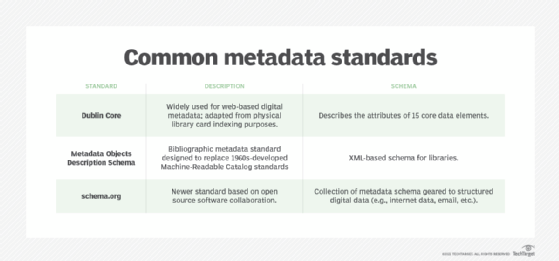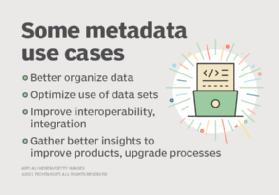Dublin Core
What is Dublin Core (DC)?
Dublin Core is an international metadata standard formally known as the Dublin Core Metadata Element Set and includes 15 metadata (data that describes data) terms. These terms offer expanded cataloging information and improved document indexing for search engine programs.
Dublin Core consists of 15 metadata terms that provide a powerful catalog to describe web resources, improve search engine optimization (SEO) and combine metadata from different standards. The terms, along with "extension vocabularies," are known as DCMI metadata terms (or simply Dublin Core terms). These vocabularies include dozens of properties, classes, data types and vocabulary encoding schemes.
Two forms of Dublin Core exist:
- Simple Dublin Core. It expresses elements as attribute-value pairs using just the 15 metadata elements from the Dublin Core Metadata Element Set.
- Qualified Dublin Core. It adds information about encoding schemes, enumerated lists of values or other processing clues to increase the specificity of metadata. Qualifiers enable searches to be more specific, but also are more complex and can pose challenges to interoperability.
Over the years, Dublin Core has become an ISO standard. It recognizes that the language of metadata is generally the language of a resource description. To this end, it includes a registry with definitions in more than 20 languages.
Dublin Core has always held that resource discovery should be independent from the medium of the resource. So, while it targets electronic resources, it aims to be flexible enough to help in searches for more traditional formats of data as well, including books, CDs, videos, images and artworks. Websites, though, are the most common users of Dublin Core.

What is the Dublin Core Metadata Initiative?
Dublin Core is developed and maintained by the Dublin Core Metadata Initiative (DCMI). The DCMI is an independent, public and nonprofit organization engaged in the design of metadata standards to describe digital resources like webpages and physical resources like CDs and books. As an open organization, it develops interoperable online metadata standards to facilitate information search, sharing and management on the web.
The organization is a project of the Association for Information Science and Technology (ASIS&T). In addition, it is governed by its governing board, managed by an executive, and maintains relationships with various standards bodies and metadata organizations around the world to foster alignment standards for the worldwide digital ecosystem.
Dublin Core history
The roots for the Dublin Core were laid in 1994 at the 2nd International World Wide Web Conference in Chicago through discussions involving executives from the library organization OCLC, the National Center for Supercomputing Applications and other organizations. At the time, there were only about 500,000 addressable objects on the web. But, even with such a small number, users typically faced difficulty finding the resources they needed. A panel discussion during conference set the stage to find a solution to these difficulties.
These initial discussions in Chicago led to a workshop in Dublin, Ohio, in 1995 about web-based metadata semantics. The main aim of the workshop was to explore if a core set of semantics could help categorize the web and thus enable easier search and retrieval of web resources. These semantics, or metadata, were dubbed Dublin Core metadata based on the workshop's location.

In 2001, the workshop format was broadened to provide more opportunities for exchanging ideas and developing more Dublin Core metadata standards. Since 2002, the DCMI has maintained its own documentation for DCMI Metadata Terms and emerged as the de facto agency to develop metadata standards for the web. Over the years, many DCMI working groups have emerged to develop specifications relevant to metadata, including encoding syntaxes, usage guidelines and metadata models.
Dublin Core metadata set
There are 15 terms in the Dublin Core, along with several properties, classes, data types and vocabulary encoding schemes. These terms form a metadata schema that can be used to describe both physical and digital resources. At a minimum, each metadata term in Dublin Core is specified with attributes, including the following:
- Name.
- Label.
- Uniform Resource Identifier (URI).
- Definition.
- Type of term.
Dublin Core terms can be used in linked data and expressed as Resource Description Framework (RDF) vocabularies, which means they are machine-readable and can be used in semantic web and linked data applications. At the same time, the terms can be combined with other metadata terms from compatible vocabularies. Thus, they can be used in contexts such as Extensible Markup Language (XML), JavaScript Object Notation (JSON), Unified Modeling Language (UML) or relational databases by disregarding the global identifier and focusing on the natural-language text of definitions, usage notes and examples.
The 15 metadata elements in Simple Dublin Core are given below:
| Number | Element | Meaning |
| 1 |
title |
The name given the resource |
| 2 |
creator |
The person or organization responsible for the content |
| 3 |
subject |
The topic covered |
| 4 |
description |
A textual outline of the content |
| 5 |
publisher |
Those responsible for making the resource available |
| 6 |
contributor |
Those who added to the content |
| 7 |
date |
When the resource was made available |
| 8 |
type |
A category for the content |
| 9 |
format |
How the resource is presented |
| 10 |
identifier |
Numerical identifier for the content, such as a URL |
| 11 |
source |
From where the content originally derived |
| 12 |
language |
In what language the content is written |
| 13 |
relation |
How the content relates to other resources -- for instance, if it is a chapter in a book |
| 14 |
coverage |
Where the resource is physically located |
| 15 |
rights |
A link to a copyright notice |
Qualified Dublin Core includes additional metadata to improve specificity and granularity.
Dublin Core URIs, namespaces and schemas
Each DCMI term is identified with a URI. When a term URI is referenced programmatically by RDF applications, it is resolved to one of four RDF schemas. Each schema corresponds to a DCMI namespace or a set of DCMI metadata terms that are identified using a common base URI.
DCMI terms are also identified using Persistent URLs (PURLs). A PURL provides a permanent address for a resource. When a user retrieves a PURL, they will be redirected to the resource's current location, which will allow them to access the resource.
All DCMI term declarations are represented in various schema languages. Each schema defines the structure and syntax of metadata specifications in a formal schema language. Also, each schema is a machine-processable specification. Two main schema languages are supported by the DCMI community:
- XML schemas. These schemas provide a way to define the structure of XML documents, including metadata. DCMI recommends the simple DC XML schema, version 2002-12-12 and qualified DC XML Schemas, version 2008-02-11.
- RDF schemas. Since 2000, the DCMI has published machine-processable representations of Dublin Core metadata terms in RDF.
Both schemas are licensed under a Creative Commons Attribution 4.0 License.
See how automated metadata management improves business insights and learn the role of metadata in unstructured data management.
